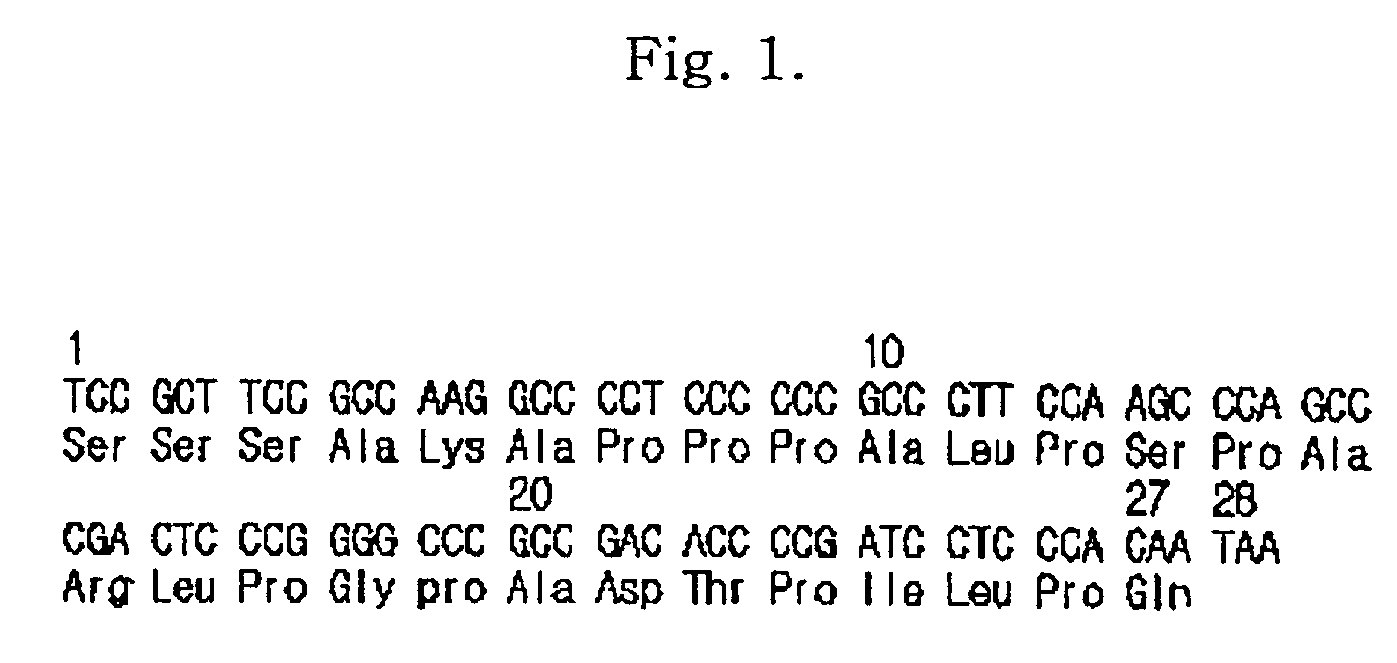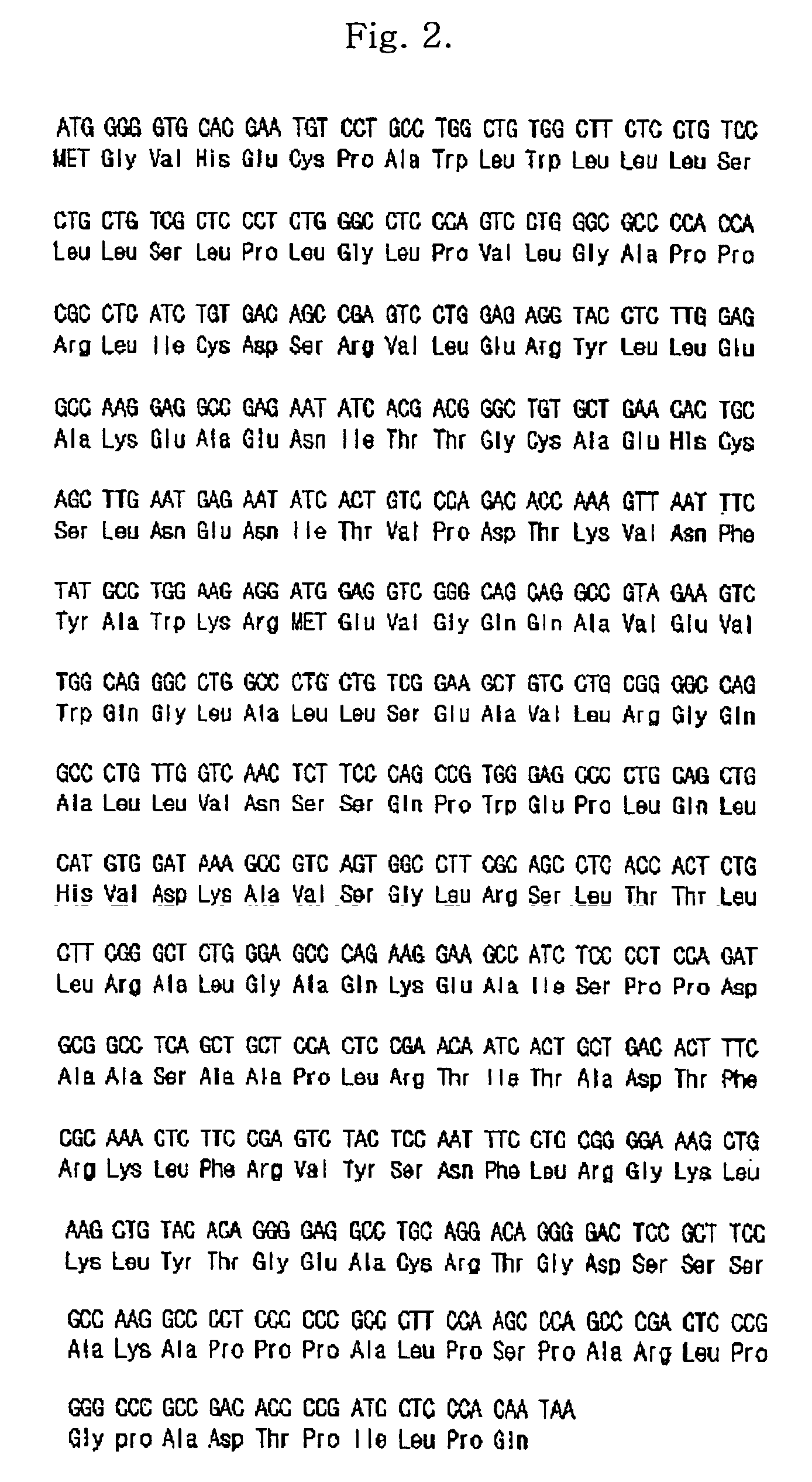Fusion protein having enhanced in vivo erythropoietin activity
a technology of erythropoietin and fusion protein, which is applied in the direction of dna/rna fragmentation, drug composition, peptide, etc., can solve the problems of inconvenience and high cost of rhepo use, extremely short half-life, and limited use of amino acids, peptides or protein fragments in this method, etc., to achieve the effect of enhancing human epo activity
- Summary
- Abstract
- Description
- Claims
- Application Information
AI Technical Summary
Benefits of technology
Problems solved by technology
Method used
Image
Examples
example 1
Acquisition of Genes
[0053]cDNA of EPO was acquired by employing a conventional RT-PCR technique using a RT-PCT Premix Kit (Bioneer Corp., Korea), in which primers EP1 and EC2 complementary to both terminals of EPO cDNA previously prepared from a cDNA library of the human embryonic liver (Invitrogen Corp.) were used. 30 cycles of PCR reactions were performed in the conditions of 35 seconds at 55° C. (annealing), 40 seconds at 72° C., and 20 seconds at 94° C., yielding EPO cDNA. The obtained EPO cDNA was cloned into a cloning vector PGEM-T (Promega Corp.). In other words, the product of PCR was eluted from 1% Agarose, ligated to pGEM-T, followed by transformation of E. coli NM522. After overnight incubation in an X-gal / IPTG smeared LB-Ampicillin solid medium, plasmid DNA was isolated from white colonies and reacted with restriction enzymes Sac I and Sac II to select colonies having EPO cDNA inserts therein. The obtained vector was termed pGEMT-EPO and its base sequence was identified ...
example 2
Construction of Expression Vector pcDNA3.1-EATP
[0058]pcDNA3.1 vector (Invitrogen) was used as expression vector. Both terminus of the EATP gene in pGEMT-EATP have Hind III and BamH I restriction sites derived from the primers EP11 and EP22.
[0059]pcDNA3.1 and the obtained pGEMT-EATP were treated with the restriction enzymes Hind III and BamH I. The linearized pcDNA3.1 and EATP gene were obtained from an Agarose gel using a Qiagen elution kit, followed by ligation, thereby transforming E. coli NM522. Plasmids were isolated from colonies resulting after incubating overnight in an LB-Ampicillin solid medium, and were treated with the restriction enzymes Hind III and BamH I. Then, only colonies inserted EATP were selected by 1% Agarose gel electrophoresis. The resultant plasmids were termed pcDNA3.1-EATP (see FIG. 3).
example 3
Transfection of CHO Cells and EATP Expression
[0060]CHO cells (DG44) were grown in a 60 mm dish to prepare 40–80% confluent cells (1–4×105 cells / 60 mm dish). 3 μL of a superfection reagent (Boehringer Manheim Corp.) and 97 μL of media (α-MEM with media, serum-free and non-antibiotic) were mixed sufficiently, and approximately 2 μg of a plasmid pcDNA3.1-EATP DNA (more than 0.1 μg / μL) and 0.2 g of a dihydrofolate reductase (dhfr) gene containing vector pLTRdhfr26 (ATCC37295) were added to the resultant mixture and reacted at room temperature for 5–10 minutes and then added to the cells. After one day elapsed, the media were replaced with α-MEM without media (containing 500 μg / mL G418) with 10% FBS. The cells were replenished with media containing 500 μg / mL G418, and cultured for 7–10 days. Then, cells without G418-resistant genes and cells of negative control group all died. After cells selected from the G418 media were sufficiently cultured, EATP protein expressed from the media was c...
PUM
| Property | Measurement | Unit |
|---|---|---|
| Intrinsic viscosity | aaaaa | aaaaa |
Abstract
Description
Claims
Application Information
 Login to View More
Login to View More - R&D
- Intellectual Property
- Life Sciences
- Materials
- Tech Scout
- Unparalleled Data Quality
- Higher Quality Content
- 60% Fewer Hallucinations
Browse by: Latest US Patents, China's latest patents, Technical Efficacy Thesaurus, Application Domain, Technology Topic, Popular Technical Reports.
© 2025 PatSnap. All rights reserved.Legal|Privacy policy|Modern Slavery Act Transparency Statement|Sitemap|About US| Contact US: help@patsnap.com



